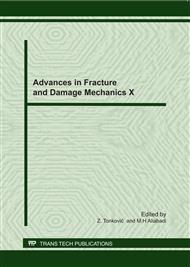p.351
p.355
p.359
p.363
p.367
p.371
p.375
p.379
p.383
The Influence of the Weld Width on Fracture Behaviour of the Heterogeneous Welded Joint
Abstract:
Since welded constructions are widely used in engineering, a certain flaws in welded joints may occur either in process of welding or in exploitation period. Easiest way to prolong working life of such welded construction is to repair welded joint to eliminate possibility of construction failure. Process of repair welding usually gives heterogeneous welded joints because during process of repair additional material is introduced into welded joint, resulting in heterogeneity from the presence of materials in welded joint point of view. Such difference in materials usually results in yield strength difference between materials, represented with mismatch ratio, and it is commonly present in welds where high strength low-alloyed (HSLA) steels were welded. Since I butt welded joints are very common in welding, a systematic investigation of such welds is performed and presented in this paper. Therefore in this investigation the influence of present material in heterogeneous weld and geometry of weld is investigated in context of fracture resistance of welded joint represented as yield load solutions in the first place. A flaw in form of crack was implemented in such heterogeneous weld and using finite element method yield load solutions for different combinations of weld geometry and material strength are obtained and presented in form of diagrams.
Info:
Periodical:
Pages:
367-370
Citation:
Online since:
September 2011
Authors:
Price:
Сopyright:
© 2012 Trans Tech Publications Ltd. All Rights Reserved
Share:
Citation:


